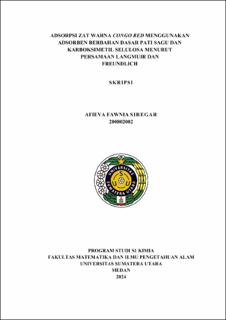Adsorpsi Zat Warna Congo Red menggunakan Adsorben Berbahan Dasar Pati Sagu dan Karboksimetil Selulosa Menurut Persamaan Langmuir dan Freundlich
Adsorption Of Congo Red Dye Using The Adsorbents Made From Sago Starch and Carboxymethyl Cellulose According to Langmuir and Freundlich Equations

Date
2024-12-30Author
Siregar, Afieva Fawnia
Advisor(s)
Nasution, Darwin Yunus
Metadata
Show full item recordAbstract
Research on adsorbents from sago starch and carboxymethyl cellulose with aluminum sulfate and boric acid cross-binding agents applied to the adsorption of congo red dye. This study aims to determine the equilibrium time of absorption of congo red, determine the absorption ability of adsorbents to congo red, and to determine the appropriate isothermal model for the adsorbents produced. The manufacture of adsorbents is carried out by mixing sago starch and CMC with aluminum sulfate and boric acid as cross-linking agents. The resulting adsorbent was then characterized by water absorption test, degree of cross-binding, FT-IR, and DSC. The results of FT-IR analysis showed that there was a change in the absorption area in the carboxylate group (C=O) with a wave number of 1587,8 cm-1 where the intensity decreased due to the cross-linking and stretching of the hydroxyl group from 3265,1 cm-1 to 3205,5 cm-1 due to the large number of –OH groups in the mixture of sago starch and CMC. The results of the thermogram in the thermal analysis using DSC produced a glass transition temperature value (Tg) of adsorbent between Tg of sago starch and Tg CMC, which was 119,26 °C, where Tg of sago starch was 121,75 °C and Tg CMC was at 115,14 °C, indicating that there had been an interaction of polymer networks between the samples. The absorption ability of congo red was determined through the absorbance value of the UV-Visible spectrophotometer analysis and determined according to the adsorption isoterm of Langmuir and Freundlich. In this study, the Langmuir adsorption isoterm is more in accordance with the value of the correlation coefficient (R2 ) of 0,9928 and the maximum absorption capacity of 3333,33 mg/g.
Collections
- Undergraduate Theses [1420]
